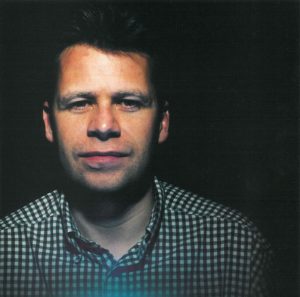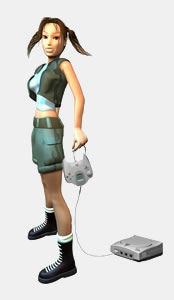This short interview with Core Design’s Director of Operations Adrian Smith appeared in the third issue of the Spanish DC Magazine (March 2000). Smith completed a MA in Computer Visualization and Animation at Bournemouth University, intending to go into the Visual Effects Industry with the goal of landing a job at Lucas VFX Company at ILM. However, he was approached by several gaming companies offering positions as a Computer Graphic Artist. He joined Rare and worked on the original Donkey Kong Country and Goldeneye. The long, stressful hours at Rare affected his health, and when Smith’s brother Jeremy left Gremlin Graphics to co-found Core Design in 1988, Adrian joined him three years later. In his position as Director of Operations, he’s been a direct witness to the development of games like Rick Dangerous and Chuck Rock for 16-bit machines, as well as Fighting Force 2 for the Dreamcast and PlayStation. Core’s greatest success has been with the creation of Lara Croft.
 Ever since we began working on this magazine, the news about a possible future installment of Tomb Raider on the Dreamcast has grown. By September, things became clear: Lara was coming with a new bra directly to the Dreamcast. Later, there was a twist and both Eidos and Core denied such a thing was going to happen (the Dreamcast part; they had no comment about the bra).
Ever since we began working on this magazine, the news about a possible future installment of Tomb Raider on the Dreamcast has grown. By September, things became clear: Lara was coming with a new bra directly to the Dreamcast. Later, there was a twist and both Eidos and Core denied such a thing was going to happen (the Dreamcast part; they had no comment about the bra).
Under this dark cloud of uncertainty and rumor, confirmations, and denials, we decided that the best thing to do was approach Core to meet with one of the bosses, Adrian Smith. He could give us the official version of events.
DC Magazine: What do you think is the industry’s perception of the Dreamcast?
Adrian Smith: I think it’s good, since Sega has done everything they said they would do. The company has suffered enough humiliation by Sony and has gone through some hard times. It now seems that they’ve focused on where they failed and have concentrated on releasing a great console with good games. When people in the industry see games like Soul Calibur, their eyes widen and they’re motivated to develop for the console. I know a lot of developers that, although they haven’t announced it, have been working on Dreamcast games. I think the platform has a great future.
DC Magazine: Core has made games for Sega in the past. What’s your current relationship with the company?
Adrian Smith: It’s been said for a long time that if you cut off our legs, it read “Sega” on the inside. Assuredly, we wouldn’t be who we are if it weren’t for Sega, which is why we respect them so much. A few years ago, Jeremy and I went to Japan to visit some friends at Sega and they showed us their plans for what is today the Dreamcast. We thought it was great then. They’ve worked very hard and released it, and we’re really pleased to see the good response it’s gotten. So, our relationship is as good as ever. Our friends are the same and we hope to make some great games for the platform.
DC Magazine: Until now, you’ve only announced Fighting Force 2 for the Dreamcast. Are you waiting to see how the game does before you develop more or do you already have other projects in the pipeline?
Adrian Smith: Fighting Force 2 is the first one that will be released, but we have other projects under development. We haven’t announced them yet. What happens is that we’re still exploring the hardware to discover what exactly the machine can do. Once we’re clear we can develop a spectacular game for Sega. Either way, in the next few months we’ll be announcing a series of releases for both the Dreamcast and the PlayStation 2.
DC Magazine: Now, for the grand question…
Adrian Smith: No! Stop! I’m not going to answer! [Laughs]
 DC Magazine: Originally, Tomb Raider was going to be made for the Saturn. What are the chances of it appearing on the Dreamcast?
DC Magazine: Originally, Tomb Raider was going to be made for the Saturn. What are the chances of it appearing on the Dreamcast?
Adrian Smith: There’s a lot of confusing information about why we didn’t continue with the Saturn. We felt that Tomb Raider wasn’t a clear option for the Saturn. At that moment, the PlayStation, with its 3D possibilities, was a much better fit for the game. It wasn’t an easy decision, but it was clear that the Saturn wouldn’t let us evolve enough. Regarding the future, things are open and I can’t give an answer. Lara was with Sega. A lot of things are happening with the new generation of consoles, and we should make well-thought-out decisions.
DC Magazine: Do you still have an exclusivity contract with Sony?
Adrian Smith: The contract expired last Christmas, which means that we now have many possibilities and we should think hard about what we do. We’ll have to wait and see what happens.

Recent Comments